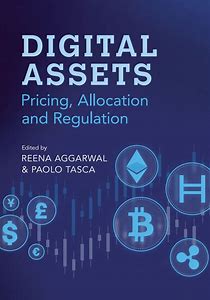Digital Assets: Pricing, Allocation and Regulation 2025. Edited by Reena Aggarwal and Paolo Tasca. Cambridge University Press. www.cambridge.org
Digital Assets delivers an extensive array of provocative articles in a compact format. From presenting methods for valuing the assets and demonstrating the impact of their inclusion on portfolio performance to dealing with rapidly evolving regulations of crypto assets, it is full of novel and sometimes complex concepts that begin with a simple question: Are digital assets a colossal bubble or will their underlying technology, blockchain, transform the world of finance?
A reader such as me, a traditional fundamental analyst, then inquires: Are digital assets, such as cryptocurrencies, true investment assets? How is their value determined? Is blockchain an investment or simply a tool to facilitate faster, complex digital bookkeeping? This volume inspires institutional investors to evaluate for themselves the risks and rewards associated with investing in digital assets and the appropriateness of such investments in portfolios.
The editors wisely selected specialists in key areas of interest including defining and evaluating digital assets, determining their suitability as institutional investments, reviewing regulations and compliance, and addressing monetary policy and central bank digital currency (CBDCs). They also presented a handy reference for dozens of digital asset-related acronyms.
The conclusions and lengthy bibliographies included in each chapter serve to solidify conceptual understanding and build upon it. There is a “voice” associated with each chapter, to the point where you want to read more of selected contributors’ work. Each reader will linger on some sections more than others, based on their level of interest in the topics.
The initial chapter, “Institutionalization of Digital Assets,” provides a comprehensive overview of the composition of digital assets. The single largest is Bitcoin, which represents 75% of the total market capitalization as of the chapter’s writing. Bitcoin is but a subset of the cryptocurrency asset class that uses encryption to conduct monetary transactions rather than a bank or third party.
The Chicago Mercantile Exchange (CME) successfully introduced regulated Bitcoin futures contracts in 2017 and now ranks as the world’s largest venue for USD Bitcoin transactions. There are also digital asset exchange traded funds (ETFs), both physical-based and futures-based. The major deterrents to widespread institutionalization are related to inefficiencies surrounding valuation, volatility, regulatory clarity, and the introduction of custodians and prime brokers. In addition, most cryptocurrency trading is executed on unregulated exchanges. These points of concern are addressed through subsequent chapters in the book. On the positive side, cryptocurrency’s low correlation with most investable asset classes could make a strong case for it as a diversifier in portfolios.
“How and When Are Cryptocurrency Predictable?” This inquiry, the focus of Chapter 2, fleshes out the back-testing of the portfolio economic value attributed to cryptocurrency. Spoiler alert: With the evidence presented in this section, readers will understand why cryptocurrencies display large monthly average returns but also massive volatilities. The authors have utilized cryptocurrency-specific factors in their predictive exercises. They conclude that based on their evidence, Bitcoin may give a first-order contribution to portfolio diversification but “will need further scrutiny before calling Bitcoin or any other companion digital currency a new asset class.” (p. 40)
How does one value a digital asset? Using a valid methodology presented in Chapter 3, “DeFi versus TradFi: Valuation Using Multiples and Discounted Cash Flows,” the authors apply conventional valuation analysis comparisons to DeFi (decentralized finance) tokens and provide a comparison with the valuation of stocks of publicly listed firms. The methodology seems quite simple, but is actually extremely complex, incorporating various components of the cryptocurrency ecosystem. The authors analyze decentralized exchanges (DEXs), protocols for loanable funds (PLFs), and yield aggregators (yield farmers and liquidity miners, viewed as return maximizers), which are compared with exchanges, banks, and asset managers, respectively. Another spoiler alert: The authors conclude that DeFi tokens have been overpriced relative to the equity of financial services firms.
“Regulations and Compliance of Digital Assets,” Part III of Digital Assets, should be compulsory reading for regulators, bankers, and asset managers globally. This large section is so well-written and presented that it serves as a compliance and regulatory blueprint for digital assets. Issues that are forefront and directly addressed in this section include KYC (Know Your Customer), AML (anti-money laundering), financing terrorism, security risk, tax evasion, transparency, and custody. The total picture cries out for global rather than fragmented regulation, especially because cryptoassets run on the internet, which has no national boundaries.
Space in this review for critiques of individual chapters is limited, but a final one must be highlighted: “Monetary Policy in a World with Cryptocurrencies, Stablecoins, and Central Banks Digital Currency (CBDC),” Chapter 10. How could digital currencies influence monetary policy? As a general matter, the balance sheet of the central bank would not change. Even if new forms of money and new currencies are introduced, the central bank does not lose its ability to control short-term interest rates and implement monetary policy. If, in the case of the US Federal Reserve, however, a foreign currency is “dollarized,” as in a stablecoin, monetary policy would lose its influence. The author argues for regulation similar to that on existing banks and financial market infrastructures to avoid runs on stablecoin issuers.
There are few criticisms to lodge against this excellent book. Through no fault of the authors, the articles are already a bit out-of-date, due to the long lead time required to produce a reference work of this quality. The latest data employed dates to 2022. The digital asset ecosystem is constantly changing, if not transforming, so anything anyone writes will instantly be outdated. Still, the concepts presented in Digital Assets remain intact.


























